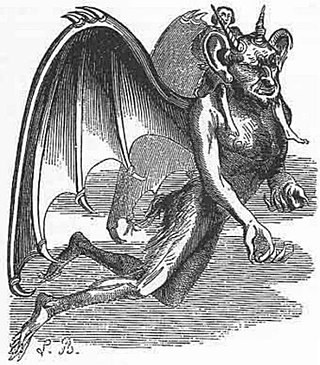In demonology, Ziminiar or Zymymar is one of the four principal kings that have power over the seventy-two demons that are supposedly constrained by King Solomon, [1] according to the Lesser Key of Solomon. Ziminiar is not to be conjured except on great occasions. The other three demon-kings are Amaymon, Corson, and Gaap (although some translations of The Lesser Key of Solomon consider the four kings to be Belial, Beleth, Asmodai, and Gaap, not specifying the cardinal direction that they rule over).
He is the king of the north according to both The Lesser Key of Solomon and Pseudomonarchia Daemonum.
Demonology is the study of demons within religious belief and myth. Depending on context, it can refer to studies within theology, religious doctrine, or occultism. In many faiths, it concerns the study of a hierarchy of demons. Demons may be nonhuman, separable souls, or discarnate spirits which have never inhabited a body. A sharp distinction is often drawn between these two classes, notably by the Melanesians, several African groups, and others. The Islamic jinn, for example, are not reducible to modified human souls. At the same time these classes are frequently conceived as producing identical results, e.g. diseases.

Asmodeus or Ashmedai is a prince of demons and hell. In Judeo-Islamic lore he is the king of both daemons (jinn/shedim) and demons (divs). Asmodeus is mostly known from the deuterocanonical Book of Tobit, in which he is the primary antagonist, or the Ars Goetia. In Peter Binsfeld's classification of demons, Asmodeus represents lust. The demon is also mentioned in some Talmudic legends; for instance, in the story of the construction of the Temple of Solomon. In Islam, he is identified with the "puppet" mentioned in the Quran, which dethroned Solomon and reigned over his kingdom until he got his kingship back.

Aamon, in demonology, is a Grand Marquis of Hell who governs 40 infernal legions, and the 7th spirit of the Goetia. He is the demon of life and reproduction.
The Lesser Key of Solomon, also known as Lemegeton Clavicula Salomonis or simply Lemegeton, is an anonymously authored grimoire on sorcery. It was compiled in the mid-17th century, mostly from materials several centuries older. It is divided into five books: the Ars Goetia, Ars Theurgia-Goetia, Ars Paulina, Ars Almadel, and Ars Notoria. It is based on the Testament of Solomon and the ring mentioned within it that he used to seal demons.

In demonology, Beleth, also spelled Bilet, Bileth, Byleth, or Bilith, is a king of Hell who has eighty-five legions of demons under his command. He rides a pale horse, and a variety of music is heard before him, according to most authors on demonology and the most known grimoires.
In demonology, Amaymon is a prince of Hell, and, according to some grimoires, the only one who has power over Asmodai.
Pseudomonarchia Daemonum, or False Monarchy of Demons, first appears as an Appendix to De praestigiis daemonum (1577) by Johann Weyer. An abridgment of a grimoire similar in nature to the Ars Goetia, it contains a list of demons, and the appropriate hours and rituals to conjure them.
In demonology, Valefar is a Duke of Hell. He tempts people to steal and is in charge of a good relationship among thieves. Valefar is considered a good familiar by his associates "till they are caught in the trap". He commands ten legions of demons.
In demonology, Morax is a Demon, Great Earl, and President of Hell, having thirty legions of demons under his command. He teaches Astronomy and all other liberal sciences, and gives good and wise familiars that know the virtues of all herbs and precious stones. This profile of the demon can be seen in Pseudomonarchia Daemonum as well as in Goetia.
Foras or Forrasis, in demonology, is a powerful President of Hell, being obeyed by twenty-nine legions of demons. He teaches logic and ethics in all their branches, the virtues of all herbs and precious stones, can make a man witty, eloquent, invisible, and live long, and can discover treasures and recover lost things.

Gaap is a demon that is described in demonological grimoires such as the Lesser Key of Solomon, Johann Weyer's Pseudomonarchia Daemonum, and the Munich Manual of Demonic Magic, as well as Jacques Collin de Plancy's Dictionnaire Infernal,
In demonology, Phenex is a Goetic demon. A Great Marquis of Hell he has twenty legions of demons under his command. He teaches all wonderful sciences, is an excellent poet, and is very obedient to the conjuror. Phenex hopes to return to Heaven after 1,200 years.

In demonology, Orobas is a powerful Great Prince of Hell, having twenty legions of demons under his control.
In demonology, Corson is one of the four principal kings that have power over the seventy-two demons that are supposedly constrained by King Solomon, according to the Lesser Key of Solomon. Corson is not to be conjured except on great occasions.

Christian demonology is the study of demons from a Christian point of view. It is primarily based on the Bible, the interpretation of these scriptures, the writings of early Christianity philosophers, hermits and the associated traditions and legends incorporated from other beliefs.

There have been various attempts at the classification of demons within the contexts of classical mythology, demonology, occultism, and Renaissance magic. These classifications may be for purposes of traditional medicine, exorcisms, ceremonial magic, witch-hunts, lessons in morality, folklore, religious ritual, or combinations thereof. Classifications might be according to astrological connections, elemental forms, noble titles, or parallels to the angelic hierarchy; or by association with particular sins, diseases, and other calamities; or by what angel or saint opposes them.
In some occult and similar writings, an archdemon, archdevil, or archfiend is a spiritual entity prominent in the infernal hierarchy as a leader of demons. Essentially, the archdemons are the evil opponents of the archangels.
Liber Officiorum Spirituum was a demonological grimoire and a major source for Johann Weyer's Pseudomonarchia Daemonum and the Ars Goetia. The original work has not been located, but some derived texts bearing the title have been found, some in the Sloane manuscripts, some in the Folger Shakespeare Library. Each version bears many similarities to each other and to the Pseudomonarchia Daemonum and the Ars Goetia, though they are far from identical.